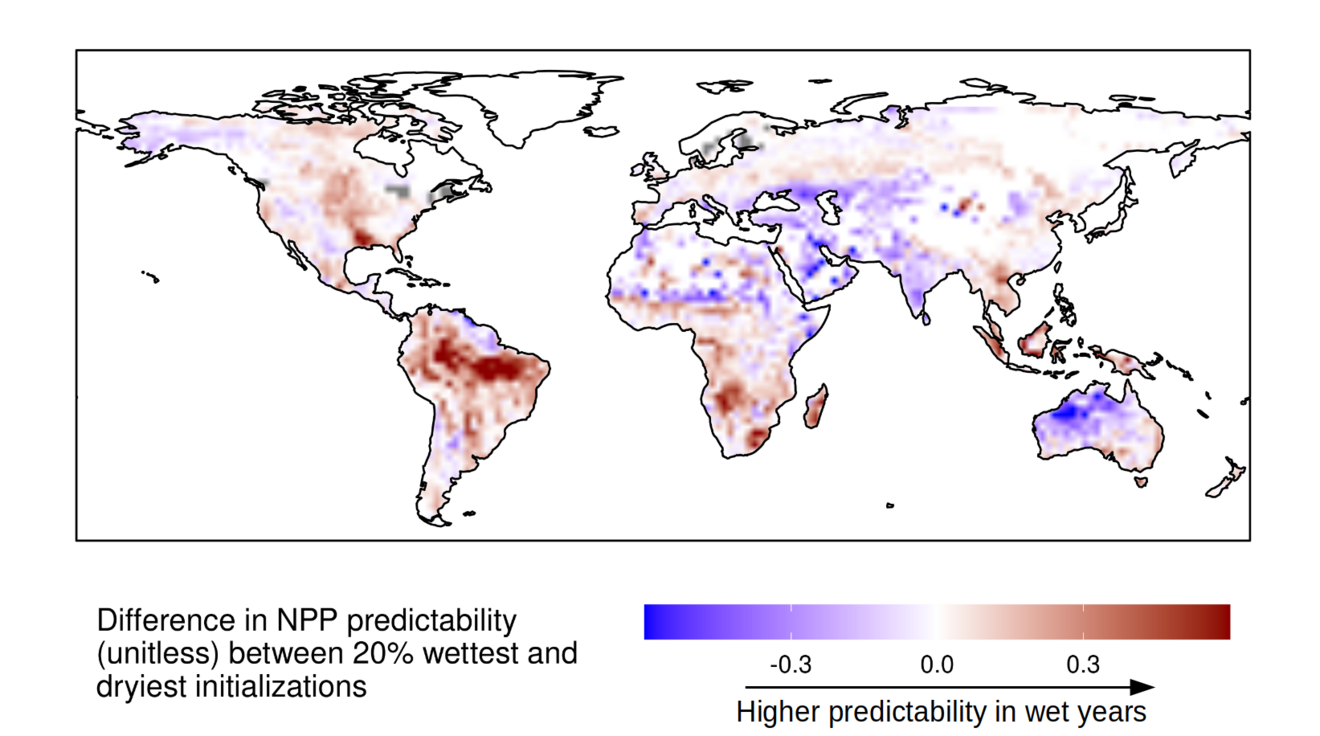The driving forces of the terrestrial carbon cycle predictability
The interannual variability in land-atmosphere carbon fluxes is the reason for the high fluctuation in atmospheric CO2 growth rate. This large variability of the land-carbon sink is the result of a general climatic variability, which can, for example, cause reduced carbon uptake by reduced plant growth, if the tropics receive below average rainfall. Moisture availability, temperature and radiation are the most important climatic drivers of the terrestrial carbon cycle. However, the relative importance of these factors is still debated. Equally uncertain are the differences in the predictability of different elements of the carbon cycle.
In this study, the authors have used the Max Planck Institute Earth System Model (MPI-ESM) to produce forecasts from arbitrary initial states, and investigated how well the model was able to predict the two main components of the terrestrial carbon cycle: net primary production (NPP) and heterotrophic respiration (Rh), which is the emission of CO2 through decomposing microorganisms. The predictability of these carbon fluxes was evaluated against the predictability of the environmental drivers to find out which of the drivers are producing the memory within the system.
The resulting ability to predict carbon fluxes was not evenly distributed around the globe, but showed distinct spatial and temporal patterns: hotspots in the Amazon basin and African savanna contributing most to the global predictability. Moisture availability was the main driver of NPP predictability. However, there are some distinct regions in which temperature has contributed to the predictability. So regional differences in carbon flux predictability can be explained by the predictability patterns of the climatic drivers, but what is causing the temporal patterns, and why do some years have a better predictability than others? To answer the first question, the authors looked at the limiting factors of the carbon fluxes. In the tropics, NPP is limited by radiation in the wet season, and soil moisture in the dry season. If the variability of NPP is caused by radiation, a high predictability of NPP cannot be expected, since radiation has a generally low predictability (there are few processes, which can provide an anomaly in cloud cover that lasts for months). However, in the dry season, when NPP is limited by moisture availability, the predictability of NPP can be highest. This is due to the high predictability of soil moisture, which is a slowly varying process and can store the effect of rainfall anomalies for several months.What about the difference between the years? Figure 1 shows that for many regions, the ability to predict NPP had something to do with how dry or wet that year might be. This effect was strongest in the Amazon basin, where NPP predictability is substantially greater in wet than in dry years. The asymmetry is a result of the system reaching its boundaries in wet years: when rainfall exceeds the water holding capacity, soils become saturated and excess water is running off into rivers or seeping into the groundwater. This mechanism ensures that when a certain precipitation threshold is exceeded, the variability of precipitation does not cause any variability in NPP since soils are saturated. A similar, but reversed effect was observable in dry regions, which had a higher predictability in dry years.

Original publication:
Dunkl, I., Spring, A., Friedlingstein, P. & Brovkin, V. (2021) Process-based analysis of terrestrial carbon flux predictability. Earth System Dynamics 12(4), 1413-1426; https://doi.org/10.5194/esd-12-1413-2021
Contact:
Istvan Dunkl
Max Planck Institute for Meteorology
Email: istvan.dunkl@mpimet.mpg.de
Dr. Aaron Spring
Max Planck Institute for Meteorology
Email: aaron.spring@mpimet.mpg.de
Prof. Victor Brovkin
Max Planck Institute for Meteorology
Email: victor.brovkin@mpimet.mpg.de
